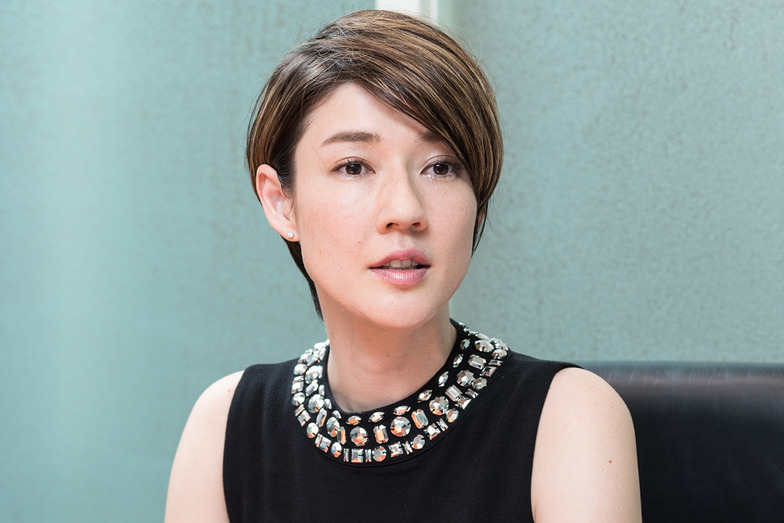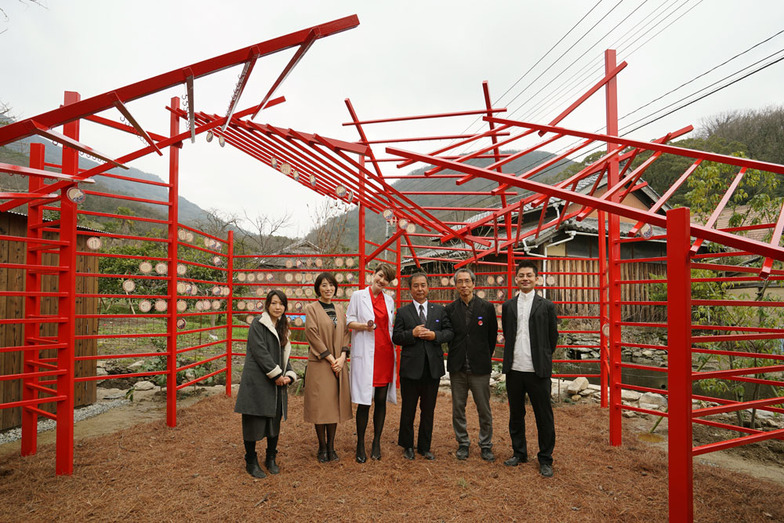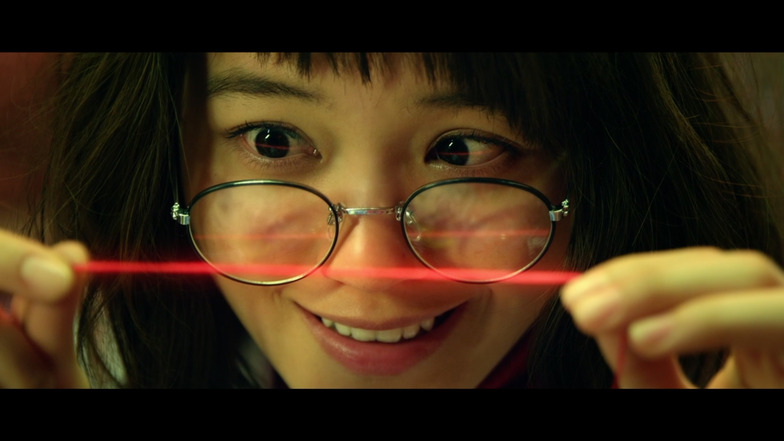The intersection of bio and digital connects to the mythical world of "eight million gods" ~ Artist/MIT Media Lab Assistant Professor Suputniko!

Sputniko!
Massachusetts Institute of Technology (MIT)

The relationship between digital technology and biology is rapidly converging, giving rise to new fields like synthetic biology. However, manipulating life carries significant risks. To consider this, perspectives beyond science—such as social critique, religion, and artistic imagination—are also necessary. A woman continues unique activities from such a multifaceted viewpoint. Her name is "Sputniko!". She serves as an assistant professor at the Massachusetts Institute of Technology (MIT) Media Lab, a cutting-edge innovation hub. She is an artist, yet also acts like a producer, and is also a scientist. We asked her, who fluidly crosses disciplinary boundaries, to speak about the unknown frontier where bio and digital intersect.
(Interviewer: Yuzo Ono, Director of Planning and Promotion, Digital Business Bureau, Dentsu Digital Inc.)

The internet, which facilitates both creation and destruction, is reshaping the form of civilization.
──Your current activities seem to encompass roles as a director, producer, scientist, and even critic. This image differs significantly from the traditional creator. Where does this approach originate?
Sputniko!: My foundational experience was undoubtedly being exposed to computers and the internet from a very young age. I started with computers at age five and the internet in fourth or fifth grade. For me, computers were tools for play and expression. I'd freely create illustrations and program-like things using Macintosh software, then post them online to get reactions. Using the internet brought human interaction into the mix, dramatically expanding the scope of play.
I believe it was because of these early experiences that, even as a student, I could find peers online and build a team environment akin to that of professional artists. I was just an ordinary student with no fame or money, but I connected to the collaborative culture of social media quite early on. I posted ideas daily on Twitter and message boards, sharing my vision, themes, and where I planned to present my work, continuously gathering people. YouTube launched in 2005, and I presented my graduate thesis project in 2010. The timing of social media's rise and my graduation project overlapped perfectly.
──Today's children are literally digital natives, born into an internet-connected world. Do you think there's a difference between this generation and yours, who distinctly remember first encountering the internet as children?
Sputniko!: Knowing the difference between life before and after the internet means we appreciate it differently compared to kids who've had it from the start. My adolescence coincided with the internet's "Renaissance," which expanded my world. But today's kids have that environment from the start. They might actually be experiencing the phenomenon of the internet making the world feel smaller. They use it without that feeling of "the world is expanding, how wonderful!"—instead, they use it to further narrow their already dense, small-world communication.
──Many people interviewed in this series shared that initial experience of feeling their world expand when they first encountered the internet. With that foundational experience missing for today's children, their perspective on the internet might naturally diverge from older generations. Speaking of the internet's power, social media is undeniably significant. What do you think social media has changed about society?
Sputniko!: I feel it has empowered minorities. For example, there was the recent blog post titled "I couldn't get my child into daycare. Japan, die!" While such absurdities likely existed ten years ago, it's precisely because social media has become mainstream that this issue surfaced now. In a society dominated by male politicians and media, women's voices gained attention and were even incorporated into parliamentary responses. However, while this power can work positively, it also facilitates gathering people for destructive activities like ISIS or hate speech. The internet is a tool that facilitates both creation and destruction. When such platforms function, I wonder where civilization is truly headed.
Moreover, the benefits extend beyond connecting people to connecting wisdom. At the MIT Media Lab, where I work, we often use the term "anti-disciplinary." Moving away from specialization, merging with other fields, or adopting perspectives from other disciplines often sparks truly fascinating ideas and innovations. Rather than mastering just one field, we look outward with an external perspective to discover new paths of evolution. That's precisely the "power of connection" – between people, between wisdom, between fields. This diversity, now connected by the internet, has dramatically expanded our world. Personally, being half-Japanese and half-American, I've been fortunate to naturally bridge people, wisdom, and fields. I want to continue raising questions by connecting diverse areas.
Speaking of diversity, this might be a slight digression, but there's something I want to say. Right now, with the 2020 Tokyo Olympics approaching, conferences themed around technology and Japan's future are being held everywhere, right? But the people attending these conferences are almost exclusively Japanese men; there are hardly any women or foreigners. Since so many different people are coming to Japan, potentially sparking innovation, I really hope diverse talent is included in these discussions. I want Japan to actively promote itself as an "open country."

How would love songs change in a society where technology has achieved immortality?
──You yourself have been engaged in unique activities broadly connecting technology and art. How do you perceive what is generally called "media art," art using digital and internet technology?
Sputniko!: Personally, I feel resistant to being called a "media artist." I think many people called media artists focus on "new expressions and aesthetics unique to that medium," like digital or the internet. But I pay attention to how human culture, ways of thinking, and activities are changing, and I end up dealing with technology as part of that process. I'm not that interested in technology itself; I'm incredibly interested in people. I believe technology and culture are one and the same, and technology serves as a driving force for culture.
For example, right now, discussions among scholars are actually happening about how advances in bio-related technology could dramatically extend human lifespan—even, in extreme cases, leading to immortality. But suppose technology did achieve human immortality. How would love songs change in that society? The definition of "eternity" in marriage vows would shift too, right? Like, "It really is forever!" (laughs). That's why I'm interested in how technology affects these analog "human desires."
──Recently, new fields like synthetic biology, where cutting-edge technologies like digital intersect with bio, have been gaining widespread attention.
Sputniko!: While synthetic biology is still a bit of a fuzzy concept for the general public now, I believe it will explode in development in the near future. Soon, more people will get involved, and we might see an era where "DIY biology" becomes popular. MIT already hosts iGEM, a contest where participants program bacteria like E. coli. It's essentially a "biological version of robotics competitions," open even to high school and college students.
As an artist, I create experimental works dealing with synthetic biology. For example, "The Silkworm Spinning the Red Thread of Fate." There's a substance called "oxytocin," sometimes called the love hormone, which is said to enhance romantic feelings between couples. So, collaborating with the National Institute for Agrobiological Sciences, we inserted the gene for producing this oxytocin and the gene for red-glowing coral into silkworms. This created silkworms that spin a "red thread of fate" containing a component for falling in love, something that previously only existed in myth.
We casually chatted with the researchers about what might happen if this were commercialized. For example, we joked about making "love-inducing bras" or "love-inducing dresses" from the silk of these "silkworms that spin the red thread of fate." Or, we said, if we wove in isoflavones—which are said to have effects similar to female hormones—we might even be able to create "breast-enhancing bras" (laughs). In this way, biotechnology holds the potential to enable the design of various new materials, and I find it incredibly fascinating to work on this.
──As these developments progress, it seems like we'll inevitably hit an ethical wall somewhere.
Sputniko!: Ethical issues are constantly discussed at the MIT Media Lab too.
One researcher is studying a technology called "gene drive," where traits created through genetic modification are passed on to 100% of offspring. For example, if you create 100 gene-drive mosquitoes that don't transmit malaria and release them into the wild, eventually all mosquitoes in nature would stop transmitting malaria. Humans could design ecosystems. Focusing solely on the elimination of malaria might seem positive, but there's also the danger that if used maliciously, it could lead to horrific consequences. Furthermore, if there were a bug in the system, countless lives could be put at risk. The researcher himself constantly grapples with the dilemma of whether it's right or wrong to pursue this kind of research. He is fully aware of the risks inherent in his work and often speaks about the need for "a platform where researchers can establish ethics while communicating with society."
I also have a colleague researching autonomous vehicles, and he's currently focusing on ethical issues. Autonomous driving requires highly sophisticated ethical judgments. For example, a scenario like: "If I continue straight ahead, I'll hit three pedestrians. If I swerve, those pedestrians will be saved, but in that case, the person in the car will be killed in the collision." It's not easy for artificial intelligence to choose the ethically correct action in such difficult situations. Perhaps there is no single correct answer. This researcher is conducting a study where they present ethical dilemmas to large numbers of people online, collecting their responses as big data to embed general ethical values into artificial intelligence. However, a car programmed with the ethical values of Country A would likely behave completely differently from one programmed with the values of Country B. A car programmed with Buddhist ethics might make different judgments than one programmed with Christian ethics. Moreover, it's unclear whether general ethical values can always be considered correct.
How to solve these problems is something we're discussing at the MIT Media Lab. It's actually far more artistic than any crude art, and while we haven't found the answer yet, I find it a fascinating theme.
A polytheistic world is coming, where humans, animals, and artificial intelligence stand on equal footing.
—It's precisely as technology encroaches upon the realms of gods and mythology. What I found intriguing is that many of your own works draw motifs from ancient myths, specifically Japanese mythology rather than Western. I wondered if this difference between monotheism and polytheism plays a significant role.
Sputniko!: Exactly. Especially in the world of biotechnology, a monotheistic narrative tends to frame it as "God vs. Science." But from a polytheistic perspective, a new world emerges where "God Absorbs Science." This polytheism, with its "eight million gods," absorbs even science itself. At Kanda Myojin Shrine in Tokyo, they even offer a "IT Information Security Prayer" amulet for computers. Traffic safety amulets only started appearing after cars came along. Polytheism is adaptable, changing with the times. I bet we'll see "Space Travel Safety Prayer" amulets soon (laughs).
The world of the future will see various religions, ethics, views on love, and family values coexisting and becoming intricately intertwined. Therefore, unless we embrace "this is acceptable, that is acceptable," the world will eventually collapse. I believe "the era of Yaoyorozu has finally arrived!" While some might associate Japanese mythology with tradition and conservatism, its essence is fundamentally different. Isn't it better to have an advanced, innovative Yaoyorozu mindset moving forward?
──Do you think the relationship between humans and other living beings will change too?
Sputniko!: Yaoyorozu and animism don't overly privilege humans; they're flat, right? A society is coming where we won't know what is human and what isn't. Both thought and human existence will become increasingly borderless. As AI expands, we'll lose the line between human and machine. If organs grown using animals are transplanted into humans, monotheistic perspectives might deem it "unforgivable," but a polytheistic mindset might accept it. That "Well, why not?" attitude of the Yaoyorozu is crucial—that stance will become increasingly valuable.
After all, even Toyotama-hime, who appears in the Kojiki, gave birth to a child while in the form of a dragon. Dragons and humans intermingled, a concept that resonates with the world of biotechnology. Thinking this way, I wonder if we're actually returning to an animistic, mythical world. Fascinated by this possibility, I launched the "Toshima Yaoyorozu Lab" project in 2016. It's a project to create myths through science and celebrate them as deities. In polytheism, that's perfectly acceptable.

──If humans and other living beings are moving toward a flat relationship, will artificial intelligence and robots also fit into that same flat hierarchy?
Sputniko!: Current AI and robots are inorganic, but I believe it will eventually be possible to embed that AI into organic matter. So, eventually, the only difference will be the material—whether inorganic or organic.
──What are your thoughts on the relationship between that artificial intelligence and humans? I often hear the argument that artificial intelligence poses a threat to humans.
Sputniko!: The underlying assumption that AI will take human jobs often stems from the idea that AI will evolve into something human-like. I don't think that's the case. Future AI will exist based on big data—not as a single entity, but as a collective of many people. That's fundamentally different from the human way of being. Furthermore, I don't think it will be independent; rather, AI will become something that humans add on to themselves. That's why at the MIT Media Lab, we argue it should be called "Extended Intelligence" rather than "Artificial Intelligence." In other words, while it's commonly said that "AI will eventually take our jobs" or "a dystopia is coming," I don't think that's the case. Before humans are eliminated by AI, I believe we will dock with it.
──There's certainly a prediction that connecting the human brain with AI will externalize human thought. But doesn't that ultimately feel like a degeneration of what humans themselves can do? What do you think?
Sputniko!: Professor Shunji Yamanaka of the University of Tokyo once said, "When photography emerged, many realist painters lost their jobs. Yet, it could also be said that photography's arrival propelled art to a new stage. Couldn't the same thing happen with intelligence?" If calculations and research can be done instantly, shouldn't we just leave that to AI and focus on cultivating our true human intelligence?
──So you're saying that AI taking over traditional human roles could actually become an opportunity for humans to cultivate true intelligence. What exactly would this "true intelligence" entail?
Sputniko!: Perhaps it's about changing one's perspective and thinking flexibly. Computers can solve problems if there's an established method, but they currently can't identify new problems, devise solutions, or shift viewpoints. Even AlphaGo, the AI that defeated humans at Go, ultimately could only play Go, right? AI can be given a perspective and told "this is the correct answer," and it will head in that direction. But figuring out what problems exist, how they should be solved, or which direction to take—that's something AI currently can't do. Take advertising, for example. Presenting what people seek or desire is something AI can do. But AI can't understand something that's really good even though nobody was asking for it. That's where I see the potential of human intelligence.
──The "design fiction" and "speculative design" you're involved in use design as a tool to raise significant questions for society's future. That seems closely related to what we just discussed—humans considering the broader direction AI can't. What do you think?
Sputniko!: I think it's similar. Raising entirely new questions is something humans excel at. I myself often pose pretty wild questions at the intersections of various fields. I'm just a contrarian at heart. That's why I don't really want to lay down the 'right answer' tracks for how the future should be. I'm not that interested in that kind of propaganda. Instead, I use the power of visuals and storytelling to just keep digging up problems. I'm forever the contrarian (laughs).
Was this article helpful?
Newsletter registration is here
We select and publish important news every day
For inquiries about this article
Back Numbers

2016/05/15
The True Potential of Civic Tech Seen from the "Future" of Marginalized Villages: Hiromi Okuda, Representative Director of With Group
2016/03/20
VR, AR, BMI, IoA... Exploring the New Relationship Between the Brain and Digital Technology ~ Naotaka Fujii, RIKEN
Author

Sputniko!
Massachusetts Institute of Technology (MIT)
Born in Tokyo in 1985, currently based in Boston. Graduated from Imperial College London with a degree in Mathematics and Computer Science, and completed a Master's degree in Design Interactions at the Royal College of Art (RCA). While still a student, began creating video works reflecting how technology is changing human existence and society. Major exhibitions include "Talk to Me" (MoMA, New York, 2011), "Tokyo Art Meeting: Usagi Smash" (Tokyo Museum of Contemporary Art, 2013), and "Design and Violence" (MoMA, New York, 2014). In 2013, he became an Assistant Professor at the MIT Media Lab and started the Design Fictions Group. His book is titled "The Power to Overflow."
